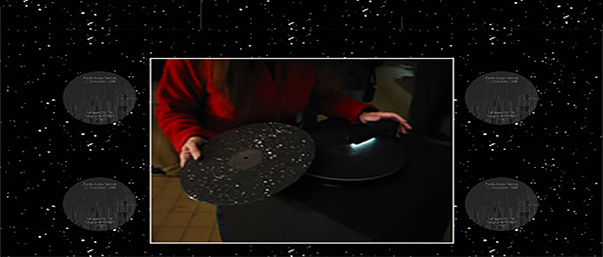Background: Working between 1886 and the 1940’s, this little known group of women astronomers is responsible for the development of schema for classifying stars by their spectra and for generating voluminous catalogs of stellar data. Their work forms the basis for the majority of the stellar maps in use today, and is the foundation for the maps used to generate the LP disks for the sculpture. The disks represent some of the more famous women astronomers of the 19th and 20th Century: Annie Jump Cannon, Williamina Fleming, Margaret Harwood, and Antonia Maury, who were part of the group. The absence of disks for the other members of the group is reflective of the then prevailing social attitudes towards women in science which resulted in many of them falling away into obscurity despite the significance of their contribution.
This historical referent is encoded in the label for each LP, which consists of a stellar spectrum, the name of each woman, along with the date and location of their birth and death, expressed in latitude and longitude. It is also encoded in the data that is digitally imaged on each LP and which is played in real time as a sound composition by the electronic sculpture. The sculpture is purposefully minimalist reflecting the relative obscurity of these women despite their significant contribution to science. Reminiscent of radio astronomy recordings yet hauntingly familiar, the sound is the transcoding of the lives of these women and their scientific contributions through the data they generated.
Installation: Stars is an interactive sound installation. One of several 12″ vinyl disks, reminiscent of an old LP, containing the images of stars in the night sky, is placed upon a slowly rotating turntable platter. As the sensor arm reads the unique dot pattern on the disk surface, it is simultaneously transformed in to a sound composition. The moveable LED sensor arm allows for disks to be interchanged. The dot patterns on each disk are generated from astronomical map data showing the position and relative luminance of stars. They correspond to the full hemisphere night sky for a specific date, latitude, and longitude, at midnight. The dates and locations used to create the disks, represent the birth or death of several of the women members of the Harvard College Observatory, collectively known as The Harvard Computers. The luminance of each star (dot) is used to generate the duration, volume and pitch of the sound it generates. As each disk rotates under the sensor arm a unique yet repetitive tonal pattern emerges. The sound generated is suggestive of a mixture of radio astronomy recordings and the experience of listening to music on a worn vinyl LP.
Specifications: The Stars installation is free-standing and comprises a slowly rotating turntable, a custom built movable electronic sensor arm, an EZI/O interface board, a Macintosh computer and two speakers in a custom built enclosure. One of a number of 12″ vinyl disks can be placed onto the platter, and the unique pattern of white dots is read by the sensing arm, which is held 1/8th of an inch above. The sensing arm itself consists of an aligned array of eight LED-Phototransistor pairs. Each pair measures the amount of incident light on the phototransistor, as reflected by the dots on the disk moving underneath. The output of each circuit is represented as a varying voltage, which is fed into the EZI/O’s analogue to digital converter. The EZI/O is connected to the Macintosh via a simple serial connection, allowing the computer to process the sensors’ readings as 8-bit values. These values are used to generate sound. Processing is achieved using custom code written in the Lingo programming language. Dimensions: L18″ X W19″ X H40

